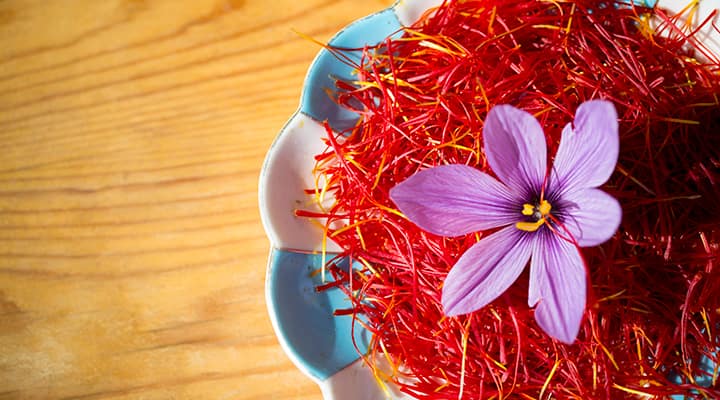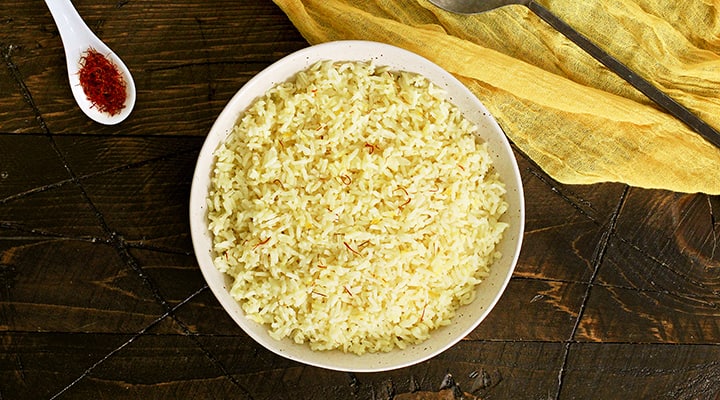
Easy and Delicious Saffron Rice Recipe
Published: February 2023
Did you know that one of the world's most popular spices, used in rice recipes like Spanish paella and Italian risotto, and in Kashmiri curries, is the most expensive spice (by weight) in the world?
The value of saffron shows in the taste and aroma it brings to your kitchen, and in the health benefits a saffron extract can help to deliver. Thankfully, saffron is versatile and easy to incorporate into flavorful teas, sauces, rices, breads and other recipes, including this easy and delicious saffron rice recipe.
What is saffron?
This spice (both as saffron threads and powder) has a distinct floral aroma and flavor and a bright yellow-gold color. It has been used throughout history as a flavorful spice for rice, sauces and drinks, a dye to color textiles, a perfume, and a health-promoting compound.
Where does saffron come from?
Although the origin of this spice is debated, it was most likely first cultivated in Greece nearly 3,000 years ago. Today, about 90% of the world's saffron is grown in Iran, while smaller amounts are grown in other countries, including India and Morocco.
It comes from the stigma (the female part) of the Crocus sativus plant. The stigmas are enclosed within the purple flowers and must be hand-harvested during a short, three-week period in the fall from October through November. Each flower only produces three red stigmas, so it takes about 150 flowers to produce just one gram of saffron!
The stigmas are picked by hand and then dried into saffron threads. This labor-intensive process explains why quality saffron is so pricey.
To make sure you're getting authentic saffron, look at it and smell it. Saffron threads should be all red stigmas with no yellow stamens, and it should smell like sweet hay.
To make sure you are getting the real thing, buy saffron threads rather than powder. This way your spice is less likely to be adulterated with less costly products, such as turmeric, red marigold petals, lily flower stigmas and corn silk threads.
Is saffron good for you?
In addition to its fragrant scent and distinctive taste, saffron has been studied for a number of health benefits. This spice contains phytochemicals that are rich in antioxidants and have been found to support a healthy mood, healthy sleep and stress management, heart health, brain health and function, menstrual comfort, sexual function, eye health and more. If weight management is a goal, it can also help you feel more full so you aren't tempted to snack between meals.
Is saffron a Spanish spice?
Saffron is used all around the world. It is a staple ingredient in rice recipes like our easy saffron rice, Spanish paella, risottos and pilafs. It is also prominent in several Persian rice dishes, such as tahchin (or tachin)—a saffron rice layered with other ingredients and meat—and taldig, which is crispy Persian rice. This spice is used in many other dishes, as well, including tea, broths, breads, marinades and desserts.
How to include saffron in your diet
If you're looking to get more saffron in your diet, the easiest way to do it is to cook it into rice or another dish or take it in supplement form.
In cooking, saffron is a versatile spice that can be used in a wide variety of recipes. It has a unique flavor that can be described as earthy with some sweet, floral notes. When saffron is broken down, it creates a yellow dye that adds a lovely color to your rice or sauce.
A little goes a long way with saffron-infused recipes. For most dishes, you'll only need a pinch to impart its rich flavor and bold yellow color. In fact, adding too much of this spice can overpower your rice, giving it a bitter, metallic taste.
The best way to draw out saffron's fragrant flavor is to soak the threads in hot water. Then add the threads and the liquid to your rice recipe. This helps the saffron bloom, heightening its aroma and flavor.
Easy saffron rice recipe to make at home
This Saffron Rice recipe is a delicious rice that is easy to make, with a total time of about 30 minutes for cooking and 10 minutes of rest before serving. Saffron imparts rich flavor and color to this rice, which is equally suitable as a side dish for special occasions or for quick weeknight meals.
Easy Saffron Rice
Makes 12 servings (about 6 cups of cooked rice)
Ingredients
¼ teaspoon saffron threads
2 tablespoons hot water
2 tablespoons olive oil
1 small yellow onion, finely chopped
2 cups uncooked basmati rice, rinsed and drained
3 ½ cups chicken stock or vegetable stock
¾ teaspoon salt
Step-by-step preparation
- Soak the saffron threads in the hot water for 10 minutes.
- Heat olive oil in a large pot over medium heat. Add the onion and cook until softened, 5-6 minutes, stirring often. Stir in the basmati rice and cook another 1-2 minutes.
- Add the saffron threads and saffron liquid to the pot along with the chicken or vegetable stock and salt. Bring to a boil over high heat. Once liquid comes to a boil, cover the pot and turn the heat to low. Simmer the rice on low heat for 20 minutes.
- Turn the heat off and let the rice sit in the covered pot another 5-10 minutes to steam. Then remove the lid and fluff rice with a fork before serving.
Nutrition
Serving size: ½ cup
Calories: 162
Carbohydrates: 28 g
Protein: 4 g
Fat: 3 g
Saturated Fat: 1 g
Polyunsaturated Fat: 0.5 g
Monounsaturated Fat: 2 g
Cholesterol: 2 mg
Sodium: 248 mg
Potassium: 122 mg
Fiber: 1 g
Sugar: 2 g
All nutritional information is based on third-party calculations and is only an estimate. Each recipe and nutritional value will vary depending on the brands you use, measuring methods and portion sizes.
Explore Our Best Weight Management Supplements
Tips for success
This saffron rice can adjusted to fit your tastes and meal plans, such as the Mediterranean diet.
- A basmati brown rice can be used in place of basmati white rice.
- You can use ghee in place of or with the olive oil to sauté your onions and rice.
- Chicken broth can be used in place of chicken stock.
- You can cook this rice in an instant pot or rice cooker instead of pan-fried and simmered on the stove top. Just be sure to transfer it to a medium-sized serving bowl after you fluff the rice so it doesn't dry out or burn.
- Saffron rice can be stored in an airtight container in the refrigerator for up to three days.
Do I get enough saffron eating saffron rice?
Even though it makes an amazing side dish, few people want to eat saffron rice every day. Even if they did, only small amounts of saffron are used in recipes like this saffron rice and other yellow rices. So supplementation is a good idea for those who want to optimize the health benefits of this spice.
Saffron is sometimes included in eye health supplements. Multiple clinical studies have shown that supplementation with this extract helps support vision and retinal function. Saffron supplements also promote feelings of fullness, which may help you control the urge to snack and support healthy weight management.
Looking for more help with healthy weight goals? Our health needs quiz can deliver supplement recommendations just for you!
References
- Broadhead, G. K., Grigg, J. R., McCluskey, P., Hong, T., Schlub, T. E., & Chang, A. C. "Saffron therapy for the treatment of mild/moderate age-related macular degeneration: a randomised clinical trial." Graefes Archive for Clinical and Experimental Ophthalmology. 2019. https://pubmed.ncbi.nlm.nih.gov/30343354/
- Heitmar, R., Brown, J. H., & Kyrou, I. "Saffron (Crocus sativus L.) in Ocular Diseases: A Narrative Review of the Existing Evidence from Clinical Studies." Nutrients. 2019. https://pubmed.ncbi.nlm.nih.gov/30889784/
- Khaksarian, M., Behzadifar, M., Behzadifar, M., Alipour, M., Jahanpanah, F., Re, T. S., Vannacci, A., Zerbetto, R., & Bragazzi, N. L. "The efficacy of Crocus sativus (Saffron) versus placebo and Fluoxetine in treating depression: a systematic review and meta-analysis." Psychology Research and Behavior Management. 2019. https://www.ncbi.nlm.nih.gov/pmc/articles/PMC6503633/
- Maleki-Saghooni, N., Karimi, F., Moghadam, Z. B., & Najmabadi, K. M. "The effectiveness and safety of Iranian herbal medicines for treatment of premenstrual syndrome: A systematic review." Avicenna Journal of Phytomedicine. 2018. https://www.ncbi.nlm.nih.gov/pmc/articles/PMC5885324/
- Ranjbar, H., & Ashrafizaveh, A. "Effects of saffron (Crocus sativus) on sexual dysfunction among men and women: A systematic review and meta-analysis." Avicenna Journal of Phytomedicine. 2019. https://www.ncbi.nlm.nih.gov/pmc/articles/PMC6727438/
- Saeedi, M. A., & Rashidy-Pour, A. "Association between chronic stress and Alzheimer's disease: Therapeutic effects of Saffron." Biomedicine & Pharmacotherapy. 2021. https://pubmed.ncbi.nlm.nih.gov/33232931/
- Sepahi, S., Ghorani-Azam, A., Hossieni, S. M., Mohajeri, S. A., & Khodaverdi, E. "Pharmacological Effects of Saffron and its Constituents in Ocular Disorders from in vitro Studies to Clinical Trials: A Systematic Review." Current Neuropharmacology. 2021. https://www.ncbi.nlm.nih.gov/pmc/articles/PMC8033960/
- Siddiqui, M. S., Saleh, M. F., Basharuddin, S. S. A., Zamri, S. N. A., Najib, M., Ibrahim, M., Noor, N. S. M., Mazha, H. N., Hassan, N. M., & Khatib, A. "Saffron (Crocus sativus L.): As an antidepressant." Journal of Pharmacy and Bioallied Sciences. 2018. https://www.ncbi.nlm.nih.gov/pmc/articles/PMC6266642/
- Tóth, B., Hegyi, P., Lantos, T., Kerémi, B., Varga, G., Tenk, J., Pétervári, E., Balaskó, M., Rumbus, Z., Rakonczay, Z., Bálint, E. R., Kiss, T., & Csupor, D. "The Efficacy of Saffron in the Treatment of Mild to Moderate Depression: A Meta-analysis." Planta Medica. 2019. https://pubmed.ncbi.nlm.nih.gov/30036891/
Always be in the know!
Access the latest deals, wellness news, expert health tips & more!









